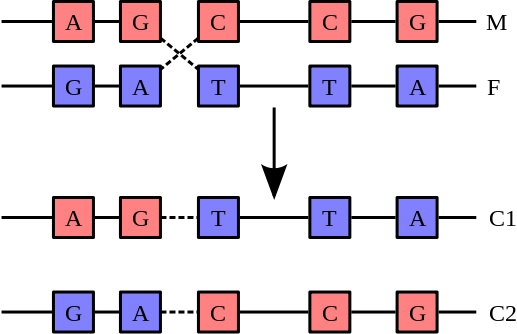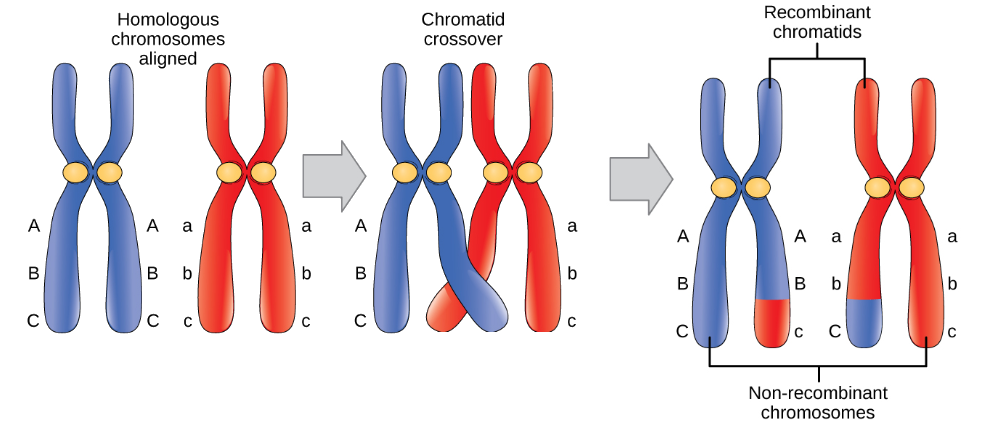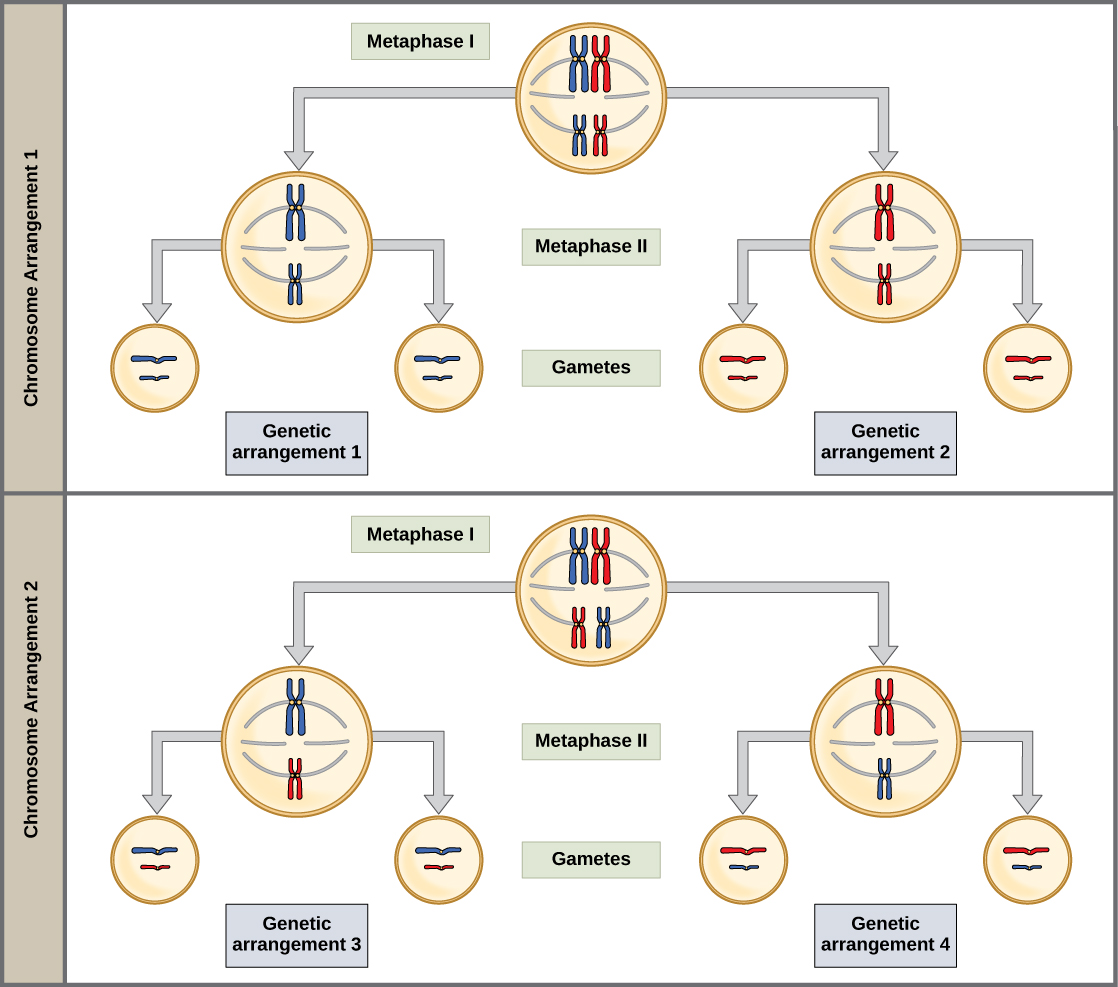How Does Independent Assortment Affect The Genetic Makeup Of Offspring Cells
7.6: Genetic Variation
- Folio ID
- 16758
Genetic variation. It is this variation that is the essence of evolution. Without genetic differences among individuals, "survival of the fittest" would not exist probable. Either all survive, or all perish.

Genetic Variation
Sexual reproduction results in infinite possibilities of genetic variation. In other words, sexual reproduction results in offspring that are genetically unique. They differ from both parents and likewise from each other. This occurs for a number of reasons.
- When homologous chromosomes form pairs during prophase I of meiosis I, crossing-over can occur. Crossing-over is the exchange of genetic cloth between homologous chromosomes. It results in new combinations of genes on each chromosome.
- When cells divide during meiosis, homologous chromosomes are randomly distributed to daughter cells, and different chromosomes segregate independently of each other. This called is chosen independent assortment. It results in gametes that have unique combinations of chromosomes.
- In sexual reproduction, ii gametes unite to produce an offspring. But which ii of the millions of possible gametes volition information technology be? This is likely to be a matter of take chances. It is obviously some other source of genetic variation in offspring. This is known every bit random fertilization.
All of these mechanisms working together result in an amazing amount of potential variation. Each human couple, for example, has the potential to produce more than than 64 trillion genetically unique children. No wonder we are all unlike!
Crossing-Over
Crossing-over occurs during prophase I, and it is the substitution of genetic cloth between not-sister chromatids of homologous chromosomes. Think during prophase I, homologous chromosomes line upward in pairs, cistron-for-gene downward their entire length, forming a configuration with 4 chromatids, known as a tetrad. At this point, the chromatids are very close to each other and some material from two chromatids switch chromosomes, that is, the material breaks off and reattaches at the same position on the homologous chromosome (Effigy \(\PageIndex{ii}\)). This commutation of genetic material can happen many times within the same pair of homologous chromosomes, creating unique combinations of genes. This process is also known as recombination.

During prophase I, chromosomes condense and become visible inside the nucleus. Every bit the nuclear envelope begins to break down, homologous chromosomes motility closer together. The synaptonemal complex, a lattice of proteins between the homologous chromosomes, forms at specific locations, spreading to encompass the unabridged length of the chromosomes. The tight pairing of the homologous chromosomes is called synapsis. In synapsis, the genes on the chromatids of the homologous chromosomes are aligned with each other. The synaptonemal complex also supports the exchange of chromosomal segments between not-sister homologous chromatids in a process called crossing over. The crossover events are the first source of genetic variation produced by meiosis. A single crossover result between homologous non-sister chromatids leads to an exchange of Deoxyribonucleic acid between chromosomes. Following crossover, the synaptonemal complex breaks downwardly and the cohesin connectedness betwixt homologous pairs is besides removed. At the end of prophase I, the pairs are held together only at the chiasmata; they are called tetrads because the 4 sister chromatids of each pair of homologous chromosomes are at present visible.

Independent Assortment and Random Fertilization
During metaphase I, the tetrads move to the metaphase plate with kinetochores facing opposite poles. The homologous pairs orient themselves randomly at the equator. This event is the second machinery that introduces variation into the gametes or spores. In each jail cell that undergoes meiosis, the arrangement of the tetrads is different. The number of variations is dependent on the number of chromosomes making up a ready. There are two possibilities for orientation at the metaphase plate. The possible number of alignments, therefore, equals 2n, where n is the number of chromosomes per set up. Given these ii mechanisms, it is highly unlikely that whatsoever two haploid cells resulting from meiosis will have the same genetic composition.

In humans, there are over 8 million configurations in which the chromosomes tin line up during metaphase I of meiosis. It is the specific procedure of meiosis, resulting in four unique haploid cells, that results in these many combinations. This independent assortment, in which the chromosome inherited from either the male parent or mother tin sort into whatever gamete, produces the potential for tremendous genetic variation. Together with random fertilization, more than possibilities for genetic variation be between any two people than the number of individuals alive today. Sexual reproduction is the random fertilization of a gamete from the female using a gamete from the male. A sperm cell, with over 8 million chromosome combinations, fertilizes an egg prison cell, which also has over 8 million chromosome combinations. That is over 64 trillion unique combinations, non counting the unique combinations produced by crossing-over.
Review
- What is crossing-over and when does information technology occur?
- Describe how crossing-over, independent assortment, and random fertilization pb to genetic variation.
- How many combinations of chromosomes are possible from sexual reproduction in humans?
- Create a diagram to show how crossing-over occurs and how it creates new gene combinations on each chromosome.
Explore More
Source: https://bio.libretexts.org/Bookshelves/Human_Biology/Book%3A_Human_Biology_(Wakim_and_Grewal)/07%3A_Cell_Reproduction/7.6%3A_Genetic_Variation
Posted by: smithgert1936.blogspot.com

0 Response to "How Does Independent Assortment Affect The Genetic Makeup Of Offspring Cells"
Post a Comment